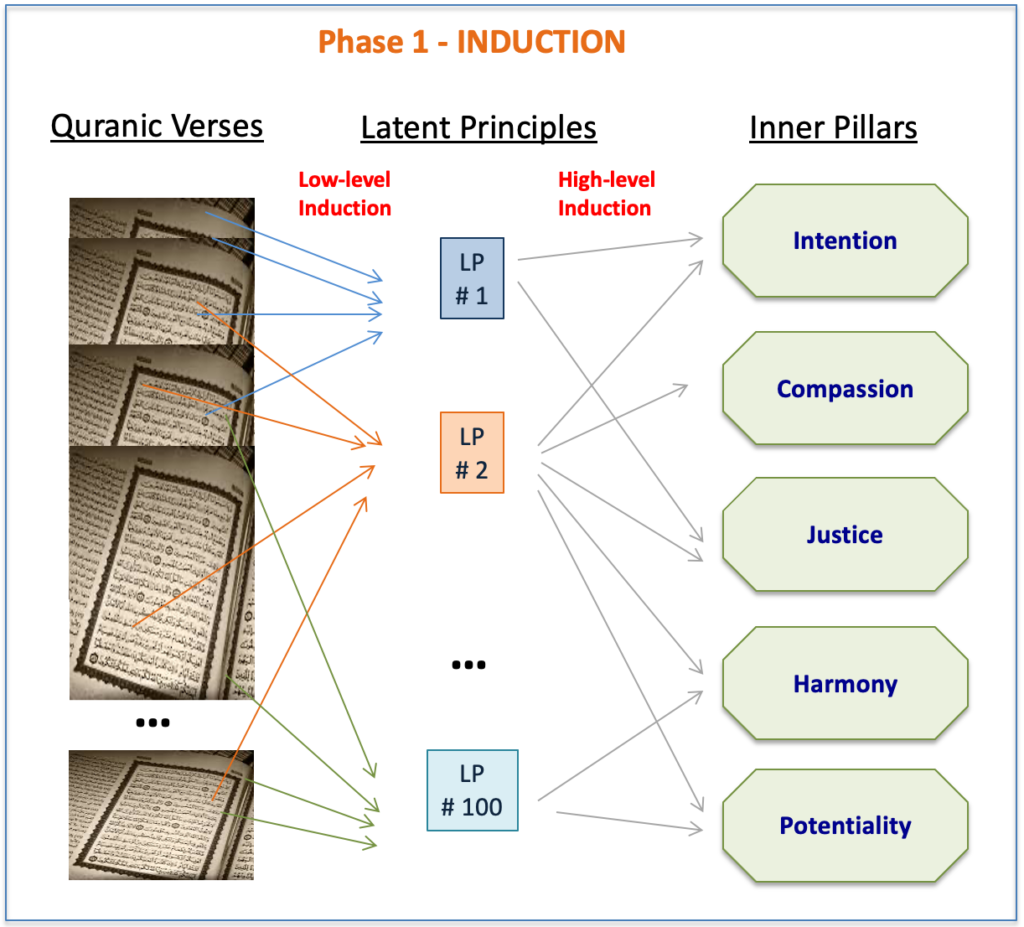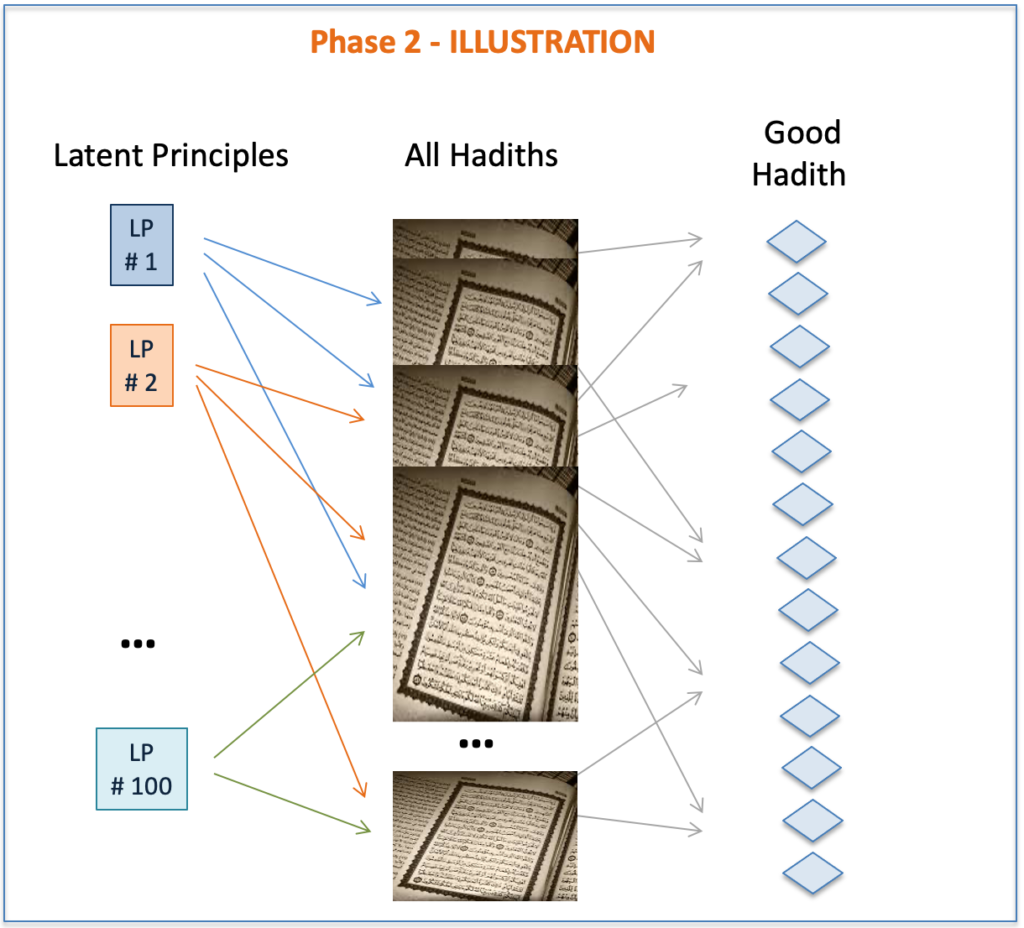BioIslam employs a Quran-led (not Quran-only) approach, consisting of a two-phase induction-illustration sequence, to comprehend the vast treasures of the Quran and post-Quranic books.
Two-phase Process
In phase 1, the latent principles (LPs) of the Quran are extracted through a process of induction (istinbat).1This will result in dozens of LPs which, upon a second round of induction, will further result in five Inner Pillars of BioIslam, supplementing the five Outer Pillars of Traditional Islam. They are Intentions, Empathy, Justice, Harmony, and Potentiality, as explained further in Latent Principles.

Next, in phase 2, further illustration of those LPs occurs reading the books of sahih Hadith and other reliable Hadith collections and re-authenticating them according to their degree of consistency with the LPs. This delivers what BioIslam considers authentic or Good Hadith, while the rest of the incompatible Hadith and almost all Sirah content is dismissed as potentially inauthentic Dark Matter. By deeming it potentially inauthentic, we are not saying all of it is definitively inauthentic, but are saying the risk of deeming an inauthentic Hadith as authentic, i.e. a false positive, is greater than the inverse, hence when in doubt cut it out. Although this method of LP-led authentication may not be error free, we view it as far better then the isnad method of Traditional Islam which is complicit in the Big Five problems. Moreover, there is sufficient depth within the Quran itself and sufficient breadth in the numerous LPs to prevent any consequential loss of knowledge.

While the Sirah, sahih Hadith and early tafsir books were accurate reflections of what Muslim scholars in that era thought might have happened during the Prophet’s time, they were writing between three to five generations after the Prophet ﷺ. Despite their diligence and good intentions, it is unlikely that they are accurate in their depiction of their past. Traditionalists believe they got it entirely right, are irrefutable, and should be quoted unreservedly for eternity. On the other extreme, the Quran-only advocates entirely disregard the post-Quranic books, which is akin to throwing the baby out with the bathwater, since not everything in those books is necessarily false. BioIslam’s linear Quran-led approach occupies a middle ground because it illustrates Quranic LPs with post-Quranic knowledge, but without having the Quran’s interpretation be governed by post-Quranic books.
Iterate Across Generations
The induction-illustration sequence is a multi-generational iterative approach. It is a dynamic process, to be repeated by every generation, informed by the accumulated wisdom of the human record, and the (hopefully) slowly-rising intelligence of our species. It stands in contrast to the traditional static view — that certain books published between the second and third Islamic centuries got it entirely right and therefore should not be challenged. Note the Quran itself takes an iterative streaming approach. It was revealed in bite-sized chunks or suras over twenty three years, underpinned by Latent Principles throughout. It evolved its message pragmatically based on practical social situations, and sometimes did so in a manner that now appears contradictory, that led many leading scholars to embrace the folly of abrogation.
A scientific mindset is inherently skeptical and questions everything, all the way back to the axioms. Thoughtful skepticism is consistent with the Quran, since in Islamic cosmology, even the most obedient of creatures, the angels, questioned God/Allah’s motive in creating humanity.2 In the absence of direct contact with the divine, we are limited by the books that survived and the “living tradition”. Yet we can be fueled and simultaneously constrained by latent Quranic wisdom.
The natural laboratory of human history has taught us much, we can lean from it to deepen our understanding of the Quran. As humanity’s experience and wisdom accrues through the centuries, across all religious and ethnic boundaries, it is likely that our powers of comprehension will improve further, albeit with occasional setbacks.3 This is why the Quran prompts us to reflect and get to know each other. There is no reason to believe that the best Islamic scholars alive today are less talented or faithful than the greatest scholars of the past, and the future might produce yet better ones.4 Each generation’s intellectuals should iteratively reread the text of the Quran, parsing it with the accumulated weight of historical wisdom gleaned from the expanding human record. In doing so, they will discover more of the latent wisdom through induction. Then they can illustrate it further through compatible selections from the vast sahih Hadith literature, and thus bring us a bit closer to comprehending the infinite depth of divine wisdom.
All Are Subjective
Critics of this approach will say this is eisegesis or ‘reading in’ our present norms and values into the text, but that is really no different from what prior generations did, even though they claimed to be doing unbiased exegesis. For example, the big Imams like Bukhari, Muslim, Abu Hanifa, Malik, Shafi’i, Hanbal and others who canonized the religious tradition in the 3rd Islamic century very likely did the same — since they did not have access to reliable source texts other than the Quran, they used their intellect to sift through the vast morass of good and bad information. It is rare for humans to operate outside the social and intellectual boundaries of their time. What the big Imams once canonized into what we now call Sunni or mainstream Islam would surely have been influenced by their cultural predispositions and their extant circumstances. As we discuss in Dark Matter, they did this through the use of back-door content (matn) analysis, also known as open content criticism, in addition to front-door transmission (isnad) analysis of Hadiths. At the Quranic level, the ulama who were troubled by a exegesis-eisegesis gap closed it through their awkward doctrine of abrogration. Later, they dangerously extended it to include cross-genre abrogation, where a Hadith can abrogate a Quranic verse when their subjective views demanded it, as discussed further in Inconvenient Implications. This suggests the Traditionalists are wishful if they perceive any gap between ‘pure’ exegesis and ‘biased’ eisegesis. Mind the gap, there isn’t one.
Footnotes
- Tariq Ramadan, Radical Reform, 60.
- This is best captured by the book title, “Even Angels Ask”, by Dr. Jeffrey Lang, a Muslim convert and Math Professor.
- Steve Pinker, Better Angels of Our Nature”.
- With the availability of more powerful analytic tools in the digital humanities, and due to the Flynn effect of rising IQs over the long term, it is likely that the quality of Islamic scholars of the future will exceed those of the past. However, given the lack of primary sources from the first Islamic century, there are limits to their impact.
